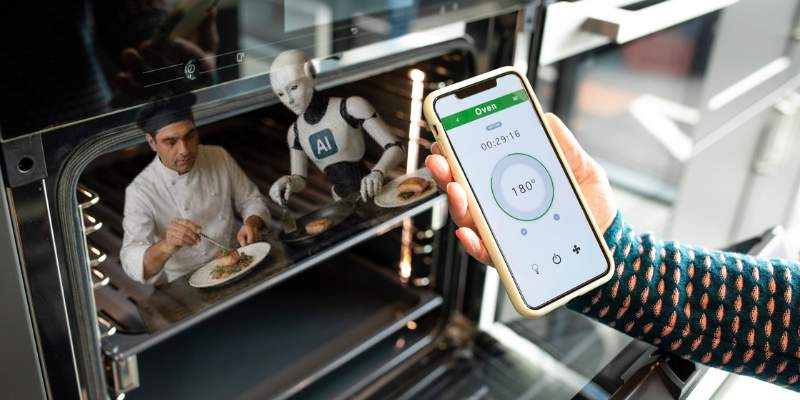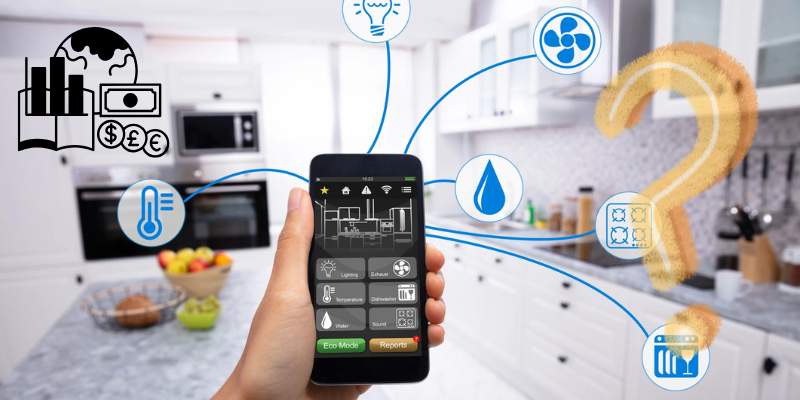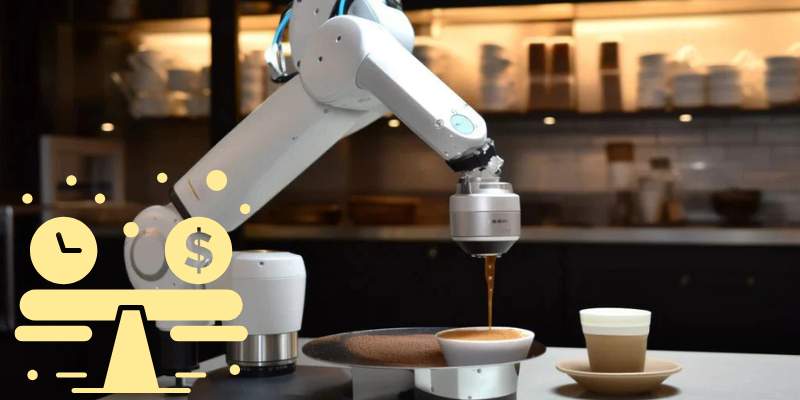There’s something comforting about the sound of a sizzling pan, the aroma of bread rising in the oven, or even the nervous glances between friends when a roast looks a little too crisp on top.
Cooking, for most of us, has always been both ritual and survival. It’s where creativity collides with necessity.
And then AI walked in.
Not content to run our cars, write our emails, or vacuum our floors, artificial intelligence is now claiming space in the kitchen. The rise of AI ovens is one of the more fascinating, and at times divisive, aspects of AI in home.
But here’s the million-dollar question: can we genuinely say that a device guided from in fully digital brains, stuffed with code and connectivity, cooks better than an experienced chef who relies on instinct, heritage, and a sprinkle of love?
That’s what I want to explore. Not just whether it’s possible, but whether it’s desirable.
What Exactly Is an AI Oven?
Before we argue about taste, let’s define the gadget.
An AI oven is a smart kitchen appliance that uses sensors, cameras, and machine learning to recognize food, adjust cooking times and temperatures, and sometimes even suggest recipes.
Imagine sliding a tray of lasagna into the oven, closing the door, and then stepping away while the device figures out—on its own—how long it should bake, when to crisp the top, and how to avoid drying out the pasta.
Some of the features include:
- Food recognition: Built-in cameras identify what you’re cooking.
- Dynamic adjustments: The oven can lower or raise temperature mid-cycle.
- Connectivity: Syncs with apps, voice assistants, and recipe databases.
- Learning ability: Over time, it notices your preferences (a little char on veggies, less browning on cookies).
- Multifunctional: Some models also act as air fryers, microwaves, or steam ovens.
If this sounds futuristic, it is. But it’s also here, right now, in kitchens across the U.S.
Why Are We Even Doing This?
There’s a part of me that wants to ask bluntly: why? Isn’t the human touch what makes food soulful?
But I also get the counterargument. Many of us are juggling jobs, kids, endless to-do lists, and the last thing we want is a soufflé collapse to remind us of our shortcomings.
AI ovens promise relief. They say: Let us handle the details. You go enjoy dinner without worrying if the chicken’s undercooked.
It’s the same cultural shift we’ve seen in washing machines, vacuums, and thermostats. We hand over small pieces of responsibility because convenience has become a form of self-care.
The Tech Under the Hood
So how do these ovens pull off their magic?
The short answer: sensors plus machine learning.
- Infrared sensors measure food surface temperatures.
- Weight sensors detect portion size.
- Cameras capture images that are compared against training data of thousands of food types.
- Algorithms process all this and adjust the cooking plan.
Which brings me to one of the trickier questions: the can we algorithms really taste food the way humans do?
Because yes, they can measure moisture loss, crispness levels, or color changes. But taste—bitterness, sweetness, acidity—that still belongs to our tongues.
A Clash Between Chefs and Machines
Professional chefs don’t just cook; they curate experiences. A pinch more salt because the tomatoes aren’t as sweet this season. A sear held five seconds longer to lock in juices. These aren’t steps you find in a codebase.
When you ask a chef whether an oven can rival their intuition, you’ll often get a laugh. Cooking is not a math equation. It’s memory, intuition, even emotion.
But then again, we said the same about chess. And algorithms eventually beat grandmasters.
The thought nags at me: if a machine can study millions of cooking outcomes, isn’t there a chance it might actually outdo a chef at technical precision, if not artistry?
Statistics: Are People Actually Buying These Things?
Yes, they are.
- According to Fortune Business Insights, the global smart oven market is expected to grow from $2.4 billion in 2023 to over $5.3 billion by 2030 (source).
- A consumer survey by Deloitte found that more than 30% of U.S. households now own at least one smart kitchen appliance, with ovens ranking among the top three categories.
So while adoption is still not mainstream, it’s growing fast. And growth in appliances usually signals that skepticism eventually gives way to familiarity.
The Pros: Why an AI Oven Might Be Worth It
Let’s give credit where it’s due. There are some compelling advantages:
- Consistency: No more burnt cookies or undercooked chicken.
- Efficiency: AI ovens often optimize energy use, which can lower utility bills.
- Time-saving: Multitasking becomes easier when the oven manages itself.
- Learning: They remember your quirks—how crisp you like bacon, how soft you want brownies.
For families who struggle with meal planning, some models even suggest recipes based on what’s in the fridge. Imagine the oven saying, “Hey, you’ve got zucchini and chicken—want me to try a quick bake?”
That’s not just convenience; it’s almost companionship.
The Cons: Where It Gets Sticky
But I can’t ignore the downsides.
- Cost: Prices often range between $1,200 and $3,000, compared to traditional ovens that cost half that.
- Complexity: More features mean more things can break.
- Data concerns: These ovens collect information about what you cook. That’s your smart data—and it raises questions about privacy.
- Loss of skill: If we rely too much on machines, do we lose the ability to cook intuitively ourselves?
I’ll admit, sometimes I find it unnerving when technology tries to know me better than I know myself.
From in Fully Automated Meals to Hybrid Cooking
One of the promises of AI ovens is the concept of “hands-off” meals. Place food inside, press a button, and come back when it’s done. A dinner from in fully digital hands, no human stress involved.
But real life is messier. What if you want to adjust the seasoning halfway? Or your recipe calls for a golden crust that doesn’t quite match what the algorithm delivers?
That’s why I think the sweet spot isn’t about replacing human cooking, but augmenting it. Machines can handle the boring stuff—timing, temperature, precision—while humans add the artistry, the tweaks, the “just because” moments that algorithms can’t predict.
Emotional Connections: Why Food Matters More Than Code
Cooking is not just about sustenance. It’s about tradition, memory, and love.
Think of the recipes passed down from grandparents. The way your mom could eyeball spices without measuring spoons. Or the pride you feel when a new dish comes out just right.
Can an oven replicate that? An do machine really carry the emotional weight of a holiday meal, where the smell of roasting turkey means togetherness?
I’m skeptical. Algorithms can nail precision, but soul? That still belongs to us.
The Hidden Trade: Convenience vs. Control
One thing I notice is that these ovens make you trade something precious—control.
Yes, they save you time. But they also make decisions for you. Maybe you like your steak just slightly tougher because that’s how your dad cooked it. An oven might flag that as “wrong” and override it unless you insist.
That’s where convenience feels less like help and more like intrusion. And once you start handing over those little choices, do you even notice when you stop being the chef in your own kitchen?
Privacy Concerns: What Happens to the Data?
I can’t ignore this part. When an AI oven logs everything you cook, it’s essentially creating a profile of your household’s eating habits.
- How often you eat pizza.
- Whether you’re vegetarian.
- If you’re cooking late at night.
That’s intimate data. And when paired with shopping apps or delivery services, it becomes a marketing goldmine.
Do I want my oven sending signals to a grocery chain about how often I roast chicken? Not really. Your smart data should stay yours.
Human vs. Machine: A Personal Perspective
Here’s my confession. I once tried a meal in a high-end AI oven demo at a tech expo. It was salmon, roasted perfectly flaky, paired with vegetables that had a surprising crispness. It was good—very good.
But you know what? Later that week, I ate my friend’s slightly overcooked chicken parmesan, made in her old, dented oven, while we laughed and drank cheap wine. And that meal? It meant more.
That’s the line for me. Precision doesn’t always equal meaning. Food is about memory, emotion, and connection as much as taste.
Where Do We Go From Here?
So where does this leave us?
I think the future is hybrid. Ovens that learn but don’t dominate. Algorithms that suggest but don’t dictate. Machines that amplify our choices rather than replace them.
Because at the end of the day, the question isn’t just can algorithms cook better than chefs? It’s do we actually want them to?
Conclusion: The Can We Algorithms Dilemma
AI ovens are impressive. They offer real convenience, consistency, and innovation. They’re part of a broader wave pushing us toward homes where machines manage daily tasks seamlessly.
But they also raise uncomfortable questions. About privacy. About dependence. About whether we’re outsourcing something that connects us deeply—to culture, to family, to ourselves.
So, can algorithms cook better than chefs? Really, it depends on how you define “better.” If better means precise, efficient, repeatable—yes, probably. If better means soulful, memorable, human—then no. Not now. Maybe not ever.
And maybe that’s okay. Because the beauty of cooking lies in the imperfections, the improvisations, the burnt edges that remind us we’re human. Machines can assist, but food, at its heart, belongs to us.


